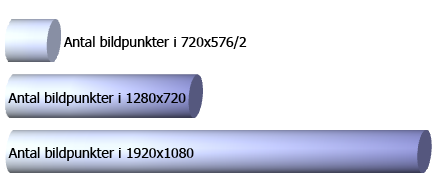Questions and Answers
About the difference between HD-quality and regular-quality.
- What is the difference between HD-quality and regular-quality?
-
There is a big difference in pixelcount. Regular movie-DVDs was the new standard when VHS tapes became obsolete, the DVDs had a lot better image quality than VHS. When the DVD standard was released we didn´t have as big TVs as we have today, and the resolution on the DVDs was enough to get a good quality on the TVs we all had back then.
Now it seems as if the TVs get bigger each year, and we need higher resolution (more pixels) to get a image quality that is good enough for those big TVs. This is the reason HD was developed, to be able to deliver high quality images on big screens.
The difference between a regular-quality movie and a HD-quality movie can be huge on a big HDTV. The size of the TV is of biggest importance, a bigger TV will show a more obvious quality difference.
All movies on DVD and actually everything that is in regular-quality will look even worse on a HD-TV (flatscreen TV) compared to a old "fat-TV". This is a fact due to de-interlacing. On a HD-TV you never get to see all the videolines since the TV will automatically filter lots of the imformation before showing it to you on the screen! So you actually never get to see the full resolution of a regular-quality transfer on a flatscreen TV, unless you are feeding it with a HD-signal..
If you want to see the difference in resolution/image quality between regular-quality and HD-quality we have lots of testclips that will show the difference.
- How big is the difference in pixel count (resolution) between regular-quality and HD-quality?
-
Regular quality and DVDs (in the european PAL standard) have a resolution of 720x576/2=207360 pixels (the videolines are divided by 2 in this calculation, because the signal is interlaced and will be de-interlaced by all flatscreen TVs).
We will transfer 8mm film to 1280x720, wich will give a total of 921.600 pixels, that is more than four times as many pixels as you would get in regular-quality.
We will transfer 16mm film to 1920x1080, wich will give a total of 2.073.600 pixels, that is ten times as many pixels as you would get in regular-quality.

- Why do you transfer 8mm film and 16mm film to different HD-resolutions?
-
Since the image surface on 8mm film is so small you already get all the details in 1280x720, there is no point to transfer it to higher resolutions than 720p. To transfer 8mm film to full HD is a little bit like the megapixelhunt in digital cameras, the manufacturers squeeze in 10 megapixel in a pocket-camera with optics that cannot even deliver half of the resolution, all you get is more noise in the images.
We don´t want to play games with unnecessary pixelhunt in a search for a level of quality that just isn´t there in the original films in the first place. We choose to deliver in a format that gives the best image quality instead of hunting for lots of pixels for nothing. We go for the best image quality, using the best hardware available.
The image surface on 16mm film is much bigger than the surface on 8mm film. That is the reason it makes sense to transfer 16mm film to the higher pixelcount, all the way up to full HD in 1920x1080. There is no doubt that it makes sense to transfer 16mm film to full HD.
- Is there any third part that can confirm that it makes sense to transfer 8mm film to HD?
-
That is a excellent question, since the earlier general opinion was that we can get all the details from 8mm film even without HD resolutions. Lots of people have tested HD transfers from 8mm film and the results are overwhelming. Everyone that has seen a proper HD transfer from 8mm film is convinced that there are more image details in HD transfers compared to regular transfers.
There is a article written about this topic in the German magazine "Smallformat", a special-magazine for 8mm and 16mm film enthusuiasts. In nr.5 2008 you can find the detailed article about HD transfers from 8mm film, written by Christoph Manz. Among his last statements Christoph writes: "A transfer of Super 8 film to HD can definetly have its advances. Sharpness and resolution can be noticeably improved over a common SD transfer."
Do you want to see the difference between regular-quality and HD-quality with your own eyes? We have testclips online that will show you the difference. They will give a much better understanding about the difference in quality than any written explanation.
- I don´t have a Blu-ray player yet. Can I get the HD-film on DVDs instead of Blu-ray?
-
No, that is not possible. The DVD player cannot read fast enough, it is not built for HD specifications.
If you don´t have a Blu-ray player yet we can make two separate recordings. We can make one Blu-ray version (that you can store in a safe place until you buy a Blu-ray player) and one version on regular DVDs, so you can view it with your regular DVD player. The cost for filmscanning is only carged for once, even if we deliver several different versions of the films.
